9 Sales Presentation Lessons From Steve Jobs’ Iphone Keynote
“Every once in a while, a revolutionary product comes along that changes everything …”
Those were the now-iconic words spoken by then-Apple CEO Steve Jobs in his 2007 MacWorld keynote.
This talk — well worth the 80-minute watch — was Jobs’ introduction (cough cough SALES PITCH) for the OG iPhone (aka, iPhone … aka iPhone 1).
It’s arguably the best sales presentation of all time, the GOAT if you will.
Hyperbole? Maybe, but Steve Jobs (and Apple) – no matter your feeling towards him or the company — have kinda sorta earned the right to hyperbole.
If you are an SDR/BDR or account executive (or anyone who does sales for a living), Jobs’ talk is something you must watch — and rewatch. It’s textbook for presentations, specifically ones that are sales in nature.
As you watch this Steve Jobs keynote (dare I say, Masterclass), be on the lookout for these 9 sales presentation lessons.
Sales Presentation Lesson #1: Demolish the status quo
“The most advanced phones are called smartphones (so they say).”
The problem, according to Steve Jobs? Smartphones are not so smart, and they’re not so easy to use.
He discusses this point around the 4-minute mark of his talk.
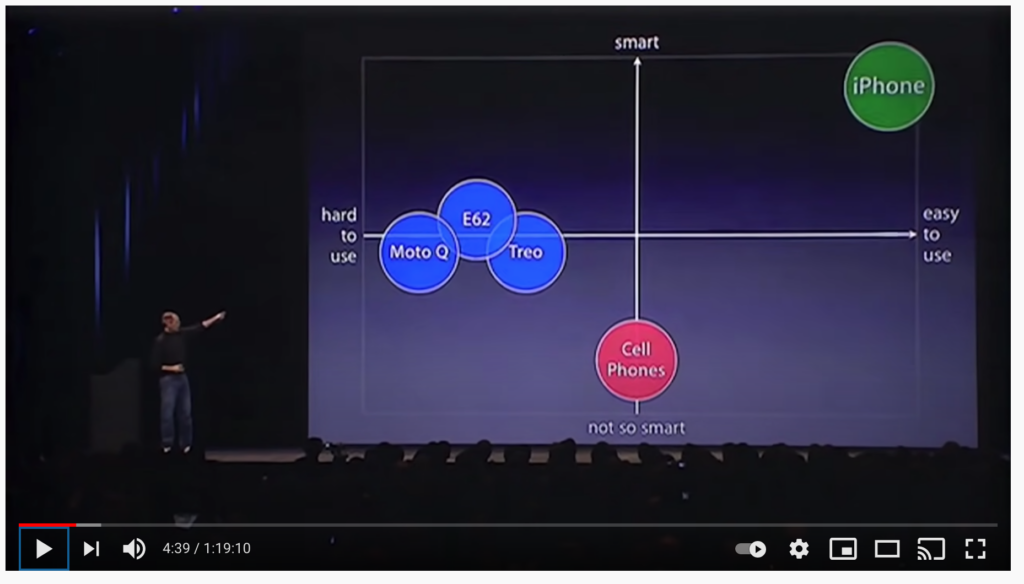
He says the current “smart” phones fall into one of the three categories:
- not so smart
- hard to use, or
- not so smart AND hard to use
It’s hard to imagine a pre-iPhone world, but the Treo, Moto Q, E62, and other cell phones were quite advanced for their time. They were pretty awesome.
But Jobs challenges that point. He shatters the status quo with a strong statement + powerful visual.
How this translates to sales: Instinct tells us to focus on the product’s benefits — (hopefully) positive and (relatively) easy to talk about.
But … focusing your message on the pain of the status quo is more persuasive than focusing on benefits.
If the status quo is no longer an option (iPhone > “smartphones”), your buyer is more likely to invest in the “new” option.
Accomplish this mindset change through the behavioral economics principle of loss aversion — humans will go to more extraordinary lengths to avoid loss than they will to gain benefits.
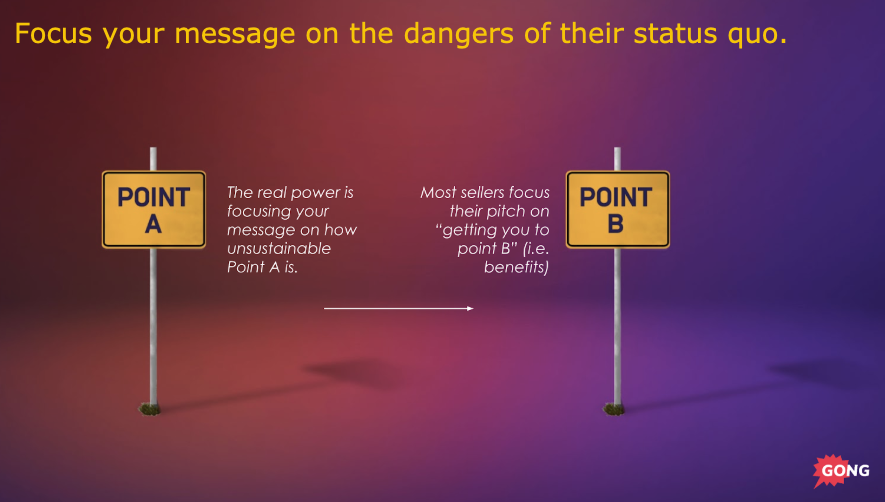
Loss aversion tugs on human nature. We will undergo 2x more effort to avoid a loss than to incur a gain.
Example #1: It’s easier to convince someone to move away from a fire (loss aversion) than to move from a chair to a comfy sofa.
Example #2: People are more motivated to NOT lose $25,000 (loss aversion) than they are to earn $25,000.
Use this psychological bias to your advantage. Your close rates will bump up if you do it right.
Start by showing why the current situation is bad (see “Business School 101” graph above) and demolish the status quo.
Sales Presentation Lesson #2: THEN show the gain
You’ve talked about how the status quo is no more. You’ve got your buyer leaning in (captivated?), on the edge of their seat.
It’s time to show the gain your product or service offers.
Steve Jobs started every demo with some version of the following: “Now what if I wanted to do X? Here’s what that looks like…”
The “I” Jobs was referring to was him in the shoes of the customer. The “what that looks like” is the gain realized from the product/service offered.
Good sales presentations show what the product can do. Great sales presentations show what the customer can do (with the product).
To accomplish this, you must answer these three questions:
- What OUTCOME did the customer achieve?
- What ACTION did the customer take to accomplish this?
- What PRODUCT BENEFIT or INSIGHT made that action possible?
Here’s a sales template to get you started:

But you are not done after showing the gain. Not quite!
Sales Presentation Lesson #3: Keep switching between status quo and gain
Sales Tip #1 (status quo), then Sales Tip #2 (gain).
Sales Tip #1 (status quo), then Sales Tip #2 (gain).
Sales Tip #1 (status quo), then Sales Tip #2 (gain).
Keep going back and forth between the status quo and the gain customers realize with your solution.
“Not the crippled stuff you find on most phones — these are the real, desktop-class applications.” About 9.5 minutes into his talk, Jobs comes back to the status quo, the “crippled stuff” … the industry-standard stuff yet is broken.
And then he hits the audience with the gain iPhone offers.
Status quo.
Gain.
Status quo.
Gain.
Back and forth. Back and forth.
Steve Jobs repeats this technique throughout the next hour+ of his talk. He keeps coming back to what he hates about the status quo over and over again to better tee up what he’s showing next.
In Nancy Duarte’s 2011 TEDxEast talk, The Secret Structure of Great Talks, she mentions this technique 6 minutes or so into her presentation (bold is mine):
“At the beginning of any presentation, you need to establish what is. You know, here’s the status quo, here’s what’s going on. And then you need to compare that to what could be. You need to make that gap as big as possible because there is this commonplace of the status quo, and you need to contrast that with the loftiness of your idea. So it’s like, you know, here’s the past, here’s the present, but look at our future. Here’s a problem, but look at that problem removed. Here’s a roadblock; let’s annihilate the roadblock. You need to really amplify that gap. This would be like the inciting incident in a movie. That’s when suddenly the audience has to contend with what you just put out there: ‘Wow, do I want to agree with this and align with it or not?’ And in the rest of your presentation should support that.
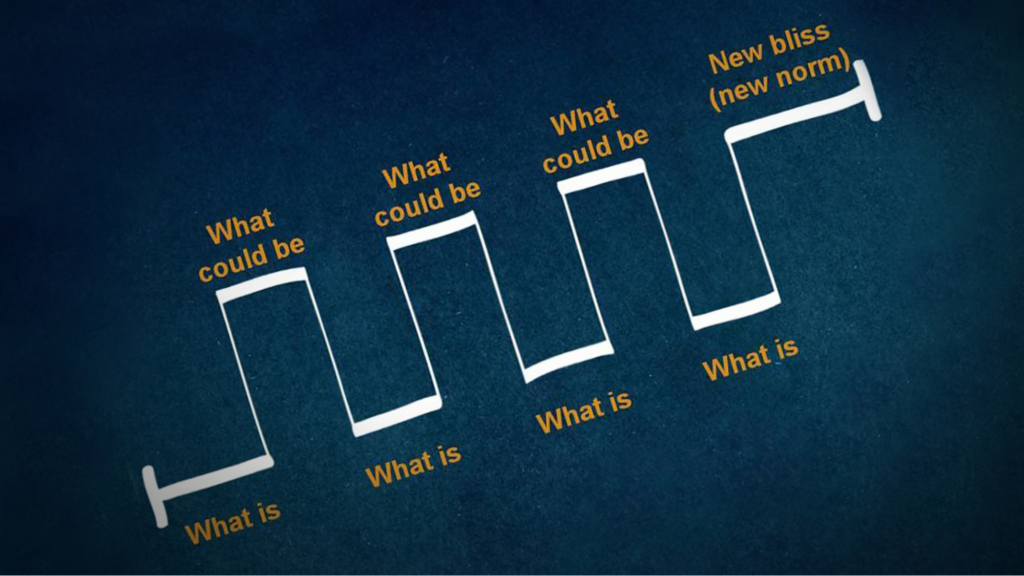
“So the middle goes back and forth; it traverses between what is and what could be, what is and what could be. Because what you are trying to do is make the status quo and the normal unappealing, and you’re wanting to draw them towards what could be in the future with your idea adopted.”
The last sentence is the key. That’s your goal: “…make the status quo and the normal unappealing … what could be in the future with your idea…”
Sales Presentation Lesson #4: Lead with the “Oh S$#T” moment
There is no massive build-up, no long lead into the punchline.
Nope.
3 minutes into an 80-minute talk (3.75% of the way through!) Steve Jobs drops the iPhone name for the first time.
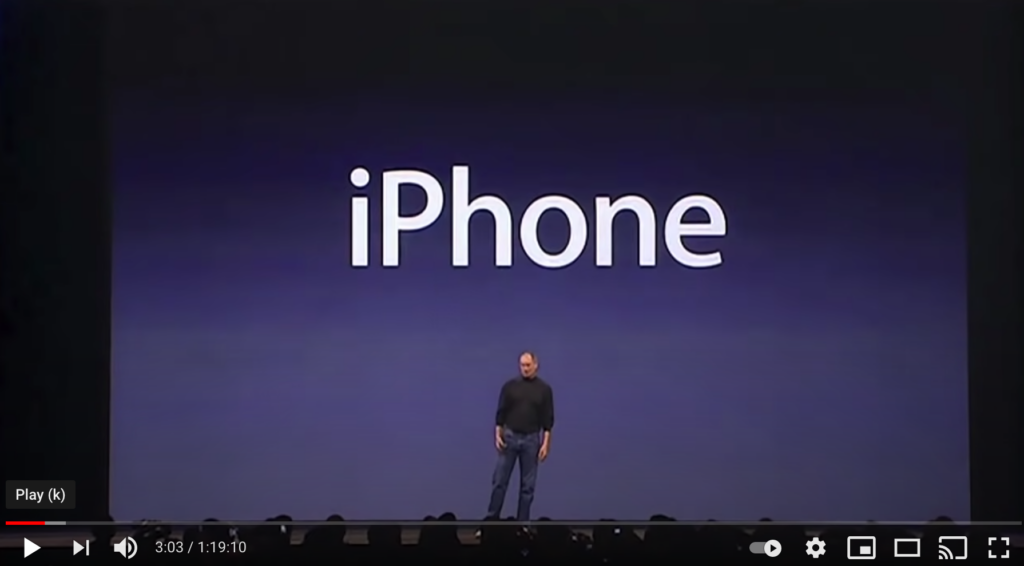
Too often, in sales pitches, there is a long lead-in, a huge build-up. We talk about our storied company history, our amazing customers, and so on.
WRONG.
Instead, flip your sales product demo upside down.
In this blog post, we share an example of a sales rep pitching a politician on building a new city on top of an empty plot of land in South Dakota. The example shows a typical sales demo.
The problem? It takes 20 minutes to get to the juicy stuff — what the city (in this case) will look like.
Flipping the demo to lead with the result (a fabulous new city in South Dakota, a revolutionary smartphone called the iPhone) takes the guesswork out.
If done effectively, you’ve now piqued interest. It’s your job to maintain that interest throughout the remainder of your pitch.
Start with the outcome and allow the conversation to unfold from there naturally.
In the 3 million web-based sales product demos we analyzed using AI, we found winning product demonstrations mirror the same priorities raised during discovery calls, in priority order.
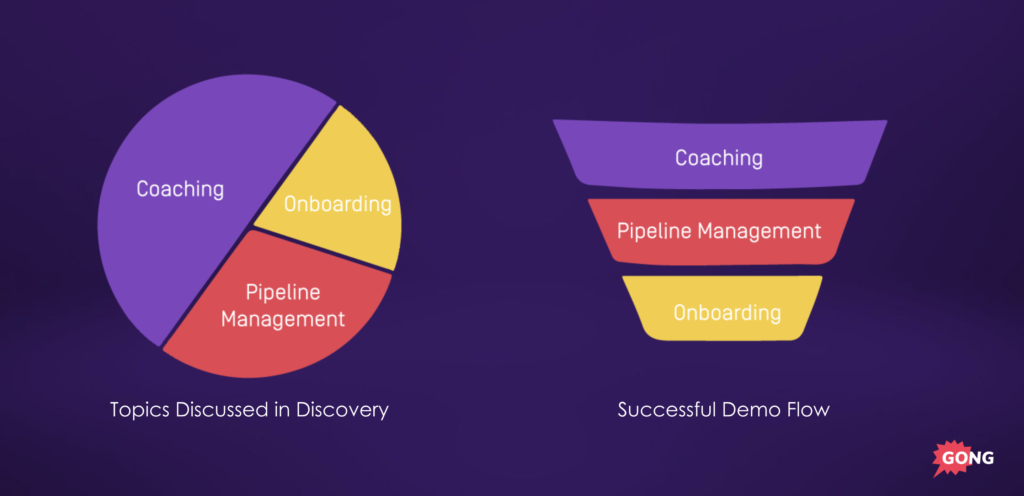
Start your sales product demo with the problem you spent the most time on during discovery, and go forward from there.
This is called “solution mapping” — helping guide you and your buyers by getting to the stuff that matters most first.
Sales Presentation Lesson #5: Obey the 9-minute rule
9.1 minutes.
For winning deals, 9.1 minutes is the average time to go through an introductory sales meeting presentation deck.
9.1 minutes.
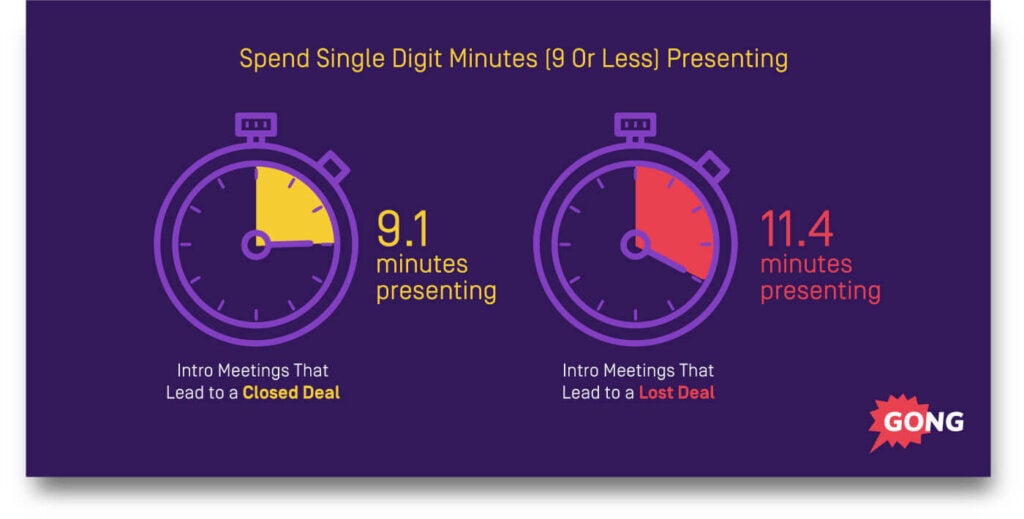
This number is backed not only by Gong data, but also by science.
Humans are complex creatures, but we are also easily distracted. SQUIRREL!
A recent study showed the average human brain now has an attention span shorter than a goldfish. What? Every time I read that study … Mind. Blown.
In some instances, this 8-second attention span serves as an advantage, but it can be tricky when selling!
While our attention starts to wander after 8 seconds or so, as we mention here, neuroscientists have proven that our brains have a built-in stopwatch that stops around 9-10 minutes.
Notice how every 9-minutes or so, Steve Jobs introduces something in his talk to “perk up” the brain … to change the pace.
To command your customer’s attention, you must introduce a “brain-perking” change of pace, such as a new speaker, a video/live demo, or a dramatic story.
The first significant shift in the Jobs keynote is when he shows a video of the new iPhone in action. Notice he’s gone from talking with images only to sharing a live video.
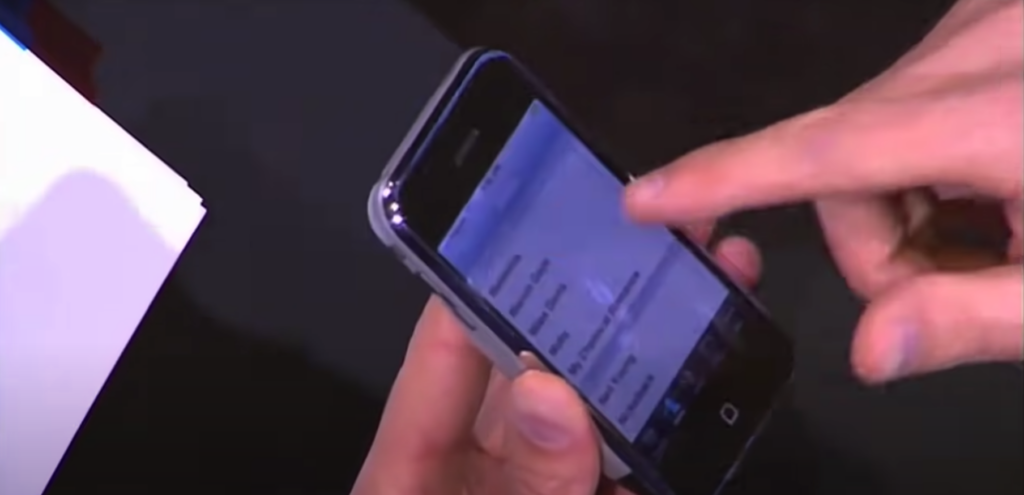
Brain switch. Powerful stuff.
Jobs continues this “every 9 minutes” switch: Story to demo to story to demo. Jobs talking followed by (then) Google CEO Eric Schmidt talking.
This constant switching throughout the entire 80-minute presentation keeps the audience engaged.
Sales Presentation Lesson #6: Simplify your slides
We’ve all seen ‘em.
We’ve all been on the other side of a slide presentation that is full of words — words the seller reads VERBATIM from the slide.
It’s painful. It’s cringeworthy. It’s a colossal waste of (everyone’s) time.
Yet “busy slides” are still an issue for many-a-sales presentations.
Notice most of Steve Jobs’ slides (from more than a decade ago, mind you):
- No lists with 17+ bullet points
- No paragraphs of words
- No fancy animations or wild things flying on and off the screen
Steve Jobs’ slides are — for the most part — a short headline + a single image. Each slide = one big idea.
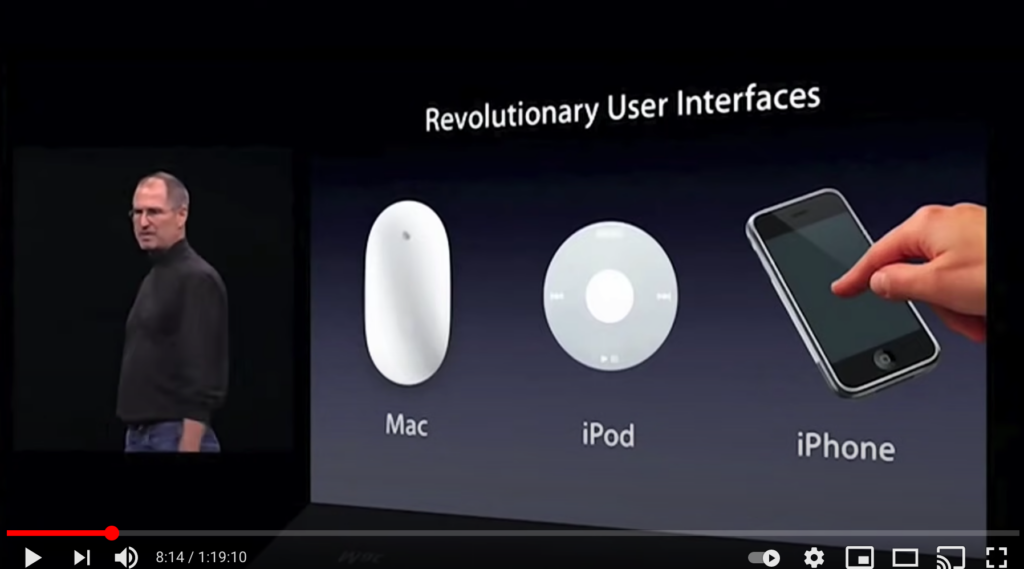
P.S. We have a brand new Sales Presentation Template — for you, for free. Grab this fill-in-the-blanks template to create knockout sales presentations.
Sales Presentation Lesson #7: Load up on pronouns
a word that can function by itself as a noun phrase and that refers either to the participants in the discourse (e.g., I, you ) or to someone or something mentioned elsewhere in the discourse (e.g., she, it, this ). — Oxford Languages
A pronoun.
Pronouns make things personal.
I. We. You.
Jobs leans heavily on the use of pronouns. You can hear them peppered throughout all of his presentations.
Example:
“Well, how do you solve this? Hmm. It turns out we have solved it. We solved it in computers 20 years ago. We solved it with a bit-mapped screen that could display anything we want. Put any user interface up. And a pointing device. We solved it with the mouse. We solved this problem. So how are we going to take this to a mobile device? What we’re going to do is get rid of all these buttons and just make a giant screen. A giant screen.”
7 “we’s” in a single paragraph!
He does the same with the pronouns “you” and “I.”
Gong has done some research on words and phrases top sellers use.
The best sales reps speak directly to buyers using the pronouns you, your, and your team 29% more often than their average and underperforming peers.
Example:
A: “Users maximize their time with this workflow.”
B: “You’ll be more efficient with this workflow.”
Can you guess which seller closes more deals?
Users vs. You. A single word can have a significant impact.
Pronouns make the person (or team) on the other end feel more part of the conversation. Pronouns flip the script from generic, vague, and indirect to personal.
Pronouns allow buyers to visualize the product or the experience. It puts them in control.
Sales Presentation Lesson #8: Give signposts at the start
Step 1: Tell them what you are going to tell them.
Step 2: Tell them.
Step 3: Tell them what you told them.
Said another way …
Step 1: Preview your key points (“give pointers at the start”). Tease out the main idea.
Step 2: Share your key points and main idea — the meat of each section.
Step 3: Summarize (Sales presentation lesson #9).
Jobs spends a lot of time on Step 2, as any good speaker should.
However, he never misses the opportunity to preview each part of his presentation. He always starts by listing what he’s going to cover before just diving in.
30 or so minutes in, Jobs introduces the SMS section: “Now what I want to do is show you SMS texting” (Step 1).
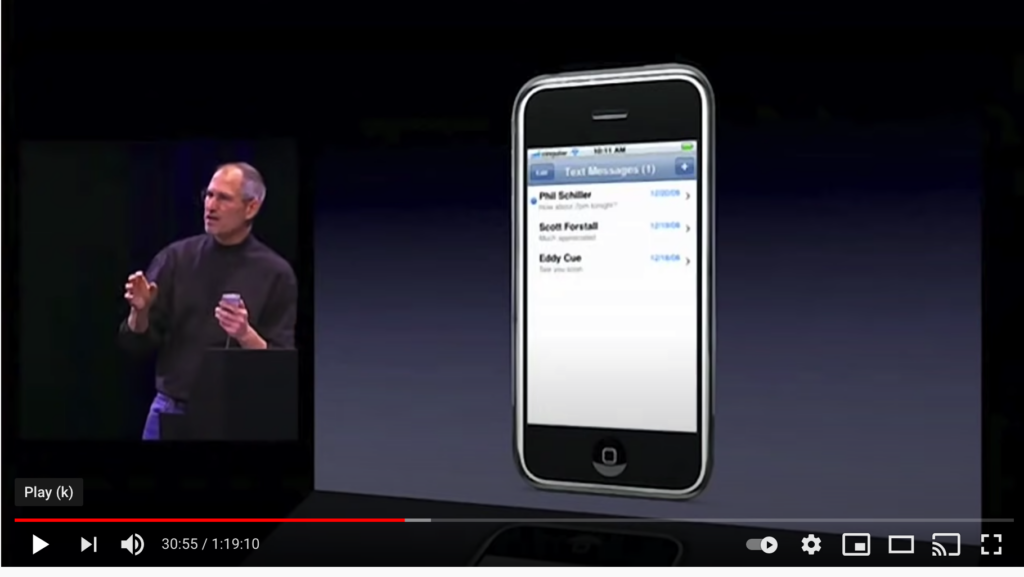
Yeah, I know. The current smartphone has come a long way with SMS texting!
And then he does it (Step 2)— shows how texting works on the new iPhone.
Boom.
Previewing upcoming content accomplishes two things:
- It alerts the buyer “your question will be answered soon.” This allows them to focus on what is being shown instead of guessing what comes next.
- It creates a clear structure — a roadmap if you will. This section is focused; we aren’t just aimlessly meandering.
Note: It’s okay to be direct, “In this next section, I’m going to tell you about XYX.” It may sound a bit robotic, but better to err on the side of directness versus ambiguity and vagueness.
Sales Presentation Lesson #9: Get back to them at the end
When moving through a long presentation, it’s crucial to break things up every 9 minutes (see: Sales presentation lesson # 5) AND summarize what you covered.
Notice how when Steve Jobs wraps up a section, he often leads with, “So again …” This type of language signals, “I’m about to change chapters. Any questions before I move on?”
He reviews and recaps what he’s just covered.
Jobs does this brilliantly while finishing the “iPod feature” section of his talk:
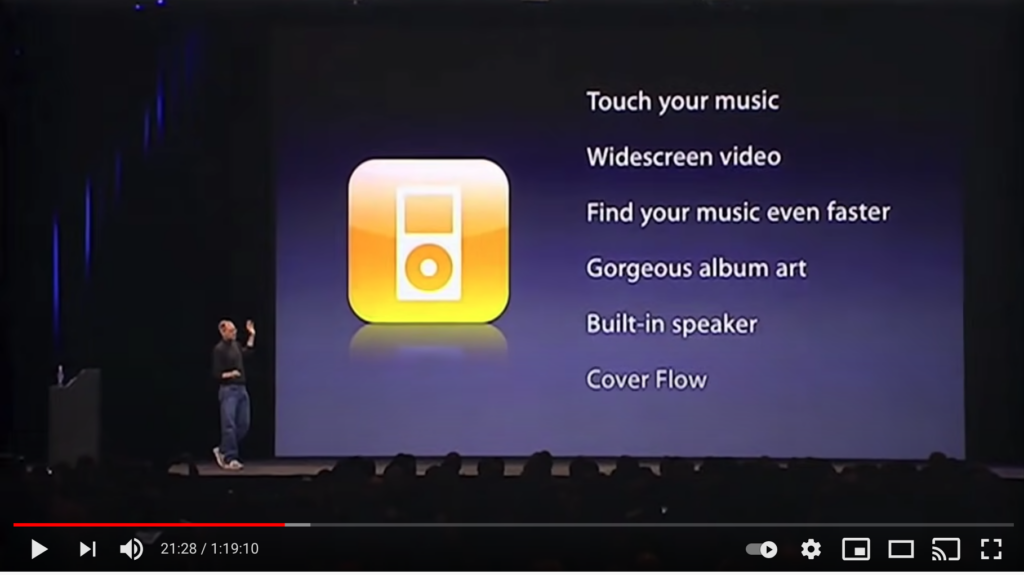
Note: While this slide appears to be counter to Sales presentation lesson #6 (Simplify Your Slides), it’s okay that he includes more words on this particular slide. After all, it’s a summary — a takeaway slide — one that may be printed (or have someone take a picture of).
This summary slide check-in is essential.
Why? Gong data show that superstar sales reps are bombarded with questions during their demos compared to their peers.
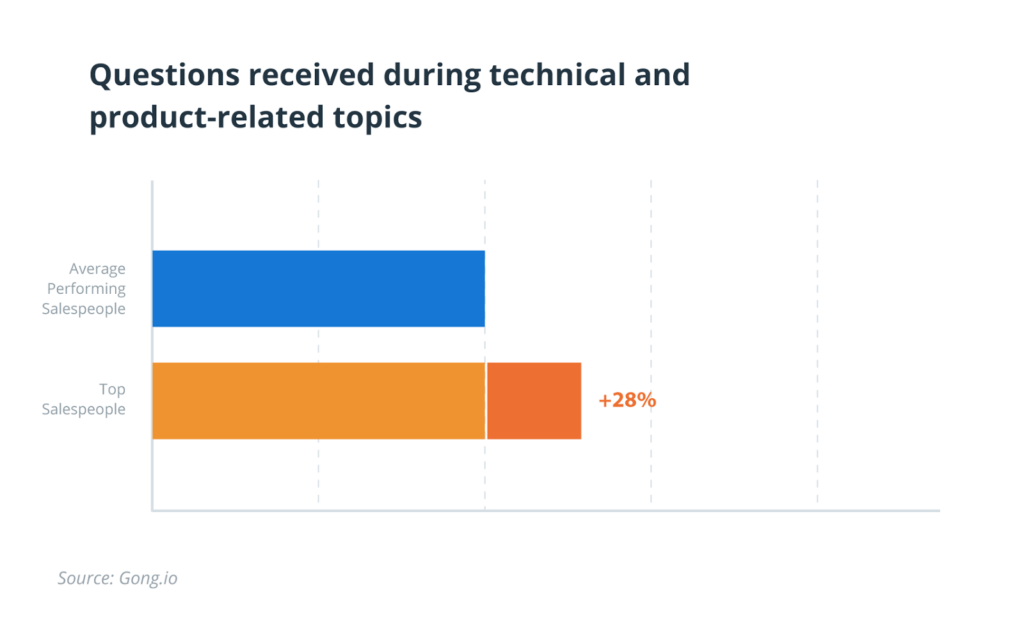
In fact, top reps get 28% more questions from their buyers during product demos and technology-related discussions than “average” sales reps.
Pausing in between sections, summarizing what you’ve just covered, and allowing time for questions is essential to your success as a salesperson.
Our gift to you: Sales Presentation Template
Steve Jobs — love him or not — was one of the most talented business presenters of all time.
He balanced confidence and hyperbole with killer content and a style that kept his audience’s attention … for more than 8 seconds.
Take the 9 sales presentation tips from his 2007 iPhone keynote and incorporate them into your next sales presentation.
Download our fill-in-the-blank Sales Presentation Template for some added flex, and start prepping your next product demo today.
